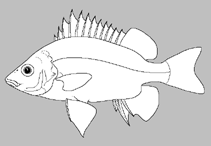Syncomistes moranensis Shelley, Delaval, Le & Feuvre, 2017
Upload your photos and videos
Pictures | Google imageNo image available for this species;
drawing shows typical species in Terapontidae.
Pictures | Google imageNo image available for this species;
drawing shows typical species in Terapontidae.
Common names from other countries
Classification / Names Common names | Synonyms | Catalog of Fishes(genus, species) | ITIS | CoL | WoRMS | Cloffa
Teleostei (teleosts) > Centrarchiformes (Basses) > Terapontidae (Grunters or tigerperches)
Etymology: Syncomistes: Greek, syn, symphysis = grown together + Greek, komistes, -ou = leader, driver (Ref. 45335); moranensis: Named for its type locality, the Moran River, which is also the only known location of the species.
Etymology: Syncomistes: Greek, syn, symphysis = grown together + Greek, komistes, -ou = leader, driver (Ref. 45335); moranensis: Named for its type locality, the Moran River, which is also the only known location of the species.
Environment: milieu / climate zone / depth range / distribution range Ecology
Freshwater; benthopelagic. Tropical
Distribution Countries | FAO areas | Ecosystems | Occurrences | Point map | Introductions | Faunafri
Oceania: Moran River within the Roe River catchment in the Kimberley region, Western Australia.
Size / Weight / Age
Short description Identification keys | Morphology | Morphometrics
Dorsal spines (total): 12; Dorsal soft rays (total): 11 - 12; Anal spines: 3; Anal soft rays: 7 - 8; Vertebrae: 24 - 26.
Prefers to inhabit deep backwaters and slow flowing stream areas. Forms shoals in the middle of the water column with Hephaestus jenkinsi. Occurs in clear waters over rocky substrates, where algae are in abundance (Ref. 119336).
Life cycle and mating behavior Maturity | Reproduction | Spawning | Eggs | Fecundity | Larvae
Main reference
Upload your references | References | Coordinator | Collaborators
Shelley, J.J, A. Delaval and M.C. Le Feuvre, 2017. A revision of the grunter genus Syncomistes (Teleostei, Terapontidae, Syncomistes) with descriptions of seven new species from the Kimberley region, northwestern Australia. Zootaxa 4367(1):1-103. (Ref. 119336)
IUCN Red List Status (Ref. 130435: Version 2024-2)
Vulnerable (VU) (D2); Date assessed: 11 February 2019
Threat to humans
Harmless
Human uses
FAO(Publication : search) | FishSource |
More information
Trophic ecology
Food items
Diet composition
Food consumption
Food rations
Predators
Food items
Diet composition
Food consumption
Food rations
Predators
Population dynamics
Growth parameters
Max. ages / sizes
Length-weight rel.
Length-length rel.
Length-frequencies
Mass conversion
Recruitment
Abundance
Growth parameters
Max. ages / sizes
Length-weight rel.
Length-length rel.
Length-frequencies
Mass conversion
Recruitment
Abundance
Life cycle
Reproduction
Maturity
Fecundity
Spawning
Spawning aggregations
Eggs
Egg development
Larvae
Larval dynamics
Reproduction
Maturity
Fecundity
Spawning
Spawning aggregations
Eggs
Egg development
Larvae
Larval dynamics
Anatomy
Gill area
Brain
Otolith
Gill area
Brain
Otolith
Physiology
Body composition
Nutrients
Oxygen consumption
Swimming type
Swimming speed
Visual pigments
Fish sound
Diseases & Parasites
Toxicity (LC50s)
Body composition
Nutrients
Oxygen consumption
Swimming type
Swimming speed
Visual pigments
Fish sound
Diseases & Parasites
Toxicity (LC50s)
Genetics
Genetics
Heterozygosity
Heritability
Genetics
Heterozygosity
Heritability
Human related
Aquaculture systems
Aquaculture profiles
Strains
Ciguatera cases
Stamps, coins, misc.
Aquaculture systems
Aquaculture profiles
Strains
Ciguatera cases
Stamps, coins, misc.
Tools
E-book | Field guide | Length-frequency wizard | Life-history tool | Point map | Classification Tree
| Catch-MSY |
Special reports
Download XML
Internet sources
Aquatic Commons | BHL | Cloffa | Websites from users | Check FishWatcher | CISTI | Catalog of Fishes(genus, species) | DiscoverLife | ECOTOX | Faunafri | Fishtrace | GenBank(genome, nucleotide) | GloBI | GOBASE | | Google Books | Google Scholar | Google | IGFA World Record | MitoFish | Otolith Atlas of Taiwan Fishes | PubMed | Reef Life Survey | Scirus | SeaLifeBase | Tree of Life | Wikipedia(Go, Search) | World Records Freshwater Fishing | Zoobank | Zoological Record
Estimates based on models
Phylogenetic diversity index (Ref. 82804): PD50 = 0.5005 [Uniqueness, from 0.5 = low to 2.0 = high].
Bayesian length-weight: a=0.01288 (0.00590 - 0.02812), b=3.04 (2.86 - 3.22), in cm Total Length, based on LWR estimates for this (Sub)family-body shape (Ref. 93245).
Resilience (Ref. 120179): Medium, minimum population doubling time 1.4 - 4.4 years (Preliminary K or Fecundity.).
Fishing Vulnerability (Ref. 59153): Low vulnerability (21 of 100).




